Tui: description and varieties, planting and care rules
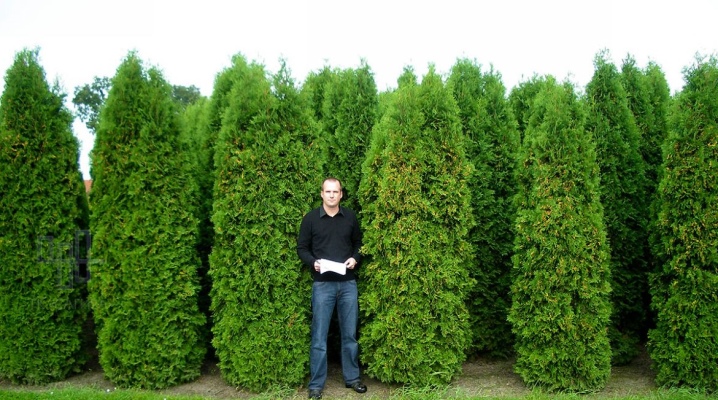
Every experienced gardener knows about such an ornamental plant as thuja. These evergreen trees have excellent frost resistance, do not require special care and are unpretentious in reproduction. In this article, you will get acquainted with the key features of thuja: a description of these plants, their varieties, as well as the rules for planting and care.
What it is?
Tui are considered one of the most popular plants of the cypress family, which are actively grown in the USA and Russia for medicinal and ornamental purposes. There are two types of these plants in relation to the structure of the seeds and the method of reproduction: gymnosperms and angiosperms. Thuja belongs to type 1 conifers. Thuja is considered the homeland of North America, as well as the territory of East Asia. The origin of the plant can be judged by the specific structure of the foliage. - it is presented in the form of scales or needles, which characterizes all conifers.
Today there are only 5 separate varieties of thuja, however, they are represented by more than 90 varieties, each of which was created for specific decorative purposes.
Tui varieties that look like columns, balls or pyramids are considered especially popular.
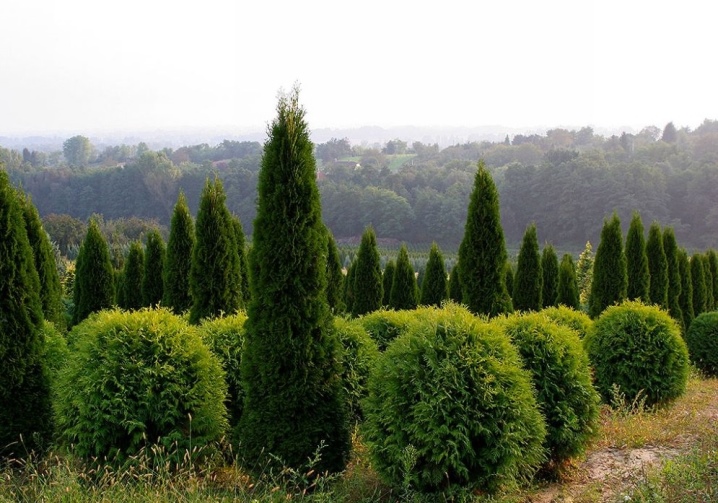
Thuja is known throughout the world for a number of advantages over other conifers:
- phenomenally long life expectancy - in the wild, thuja lives up to 200 years;
- evergreen foliage in summer and winter, which allows you to refresh any landscape;
- perfectly shows itself as a living fence;
- does not need specific care;
- easy to reproduce;
- resistant to cold and many pests;
- due to the huge number of varieties and forms, it is possible to choose the optimal variety for any requirements and conditions.
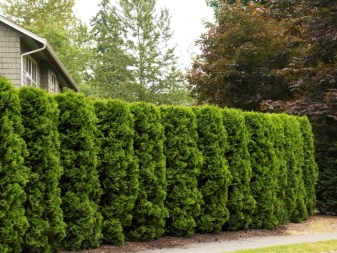
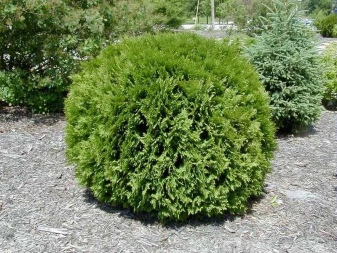
How is it different from a juniper?
Many amateur gardeners who have just got acquainted with landscape design often confuse thuja and juniper seedlings when buying. Indeed, at a young age, the seedlings of these trees are very easy to confuse: both plants have almost the same scale-like needles in color and shape. Below you can familiarize yourself with a number of signs by which you can determine what is in front of you: thuja or juniper.
Fruit
The very first point that will help determine whether your plant belongs to a particular species is the appearance of the fruit. If in thuja fruits are presented in the form of small oval and scaly cones of green, white or peach color, then the fruits of juniper are round or oval cones with a characteristic blue or dark shade.
Young juniper fruits will resemble bunches of blueberries, while adults will resemble currants. You can also identify a difference in the number of fruits on a branch: due to the small size and vertical growth of thuja fruits, they can be represented by several dozen on one branch. Juniper fruits grow more indirectly: this means that they can be located either in piles of up to 7 pieces on one branch, or individually - up to 1-3 pieces on a branch.
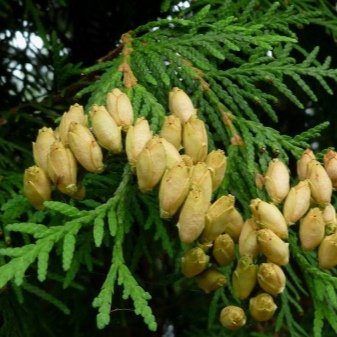
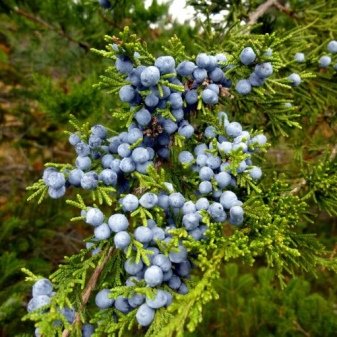
Dimensions (edit)
Although all ornamental plants used in landscaping tend to be of the same size to achieve a certain landscape balance, thuja and juniper can also be distinguished by their size. Usually, garden varieties of juniper are in order more than thuja: they can grow up to 15 meters, and garden thuja species rarely exceed 6 meters. If we talk about the natural environment, then there some varieties of thuja can grow up to 70 meters in height, and have up to 6 meters in diameter.
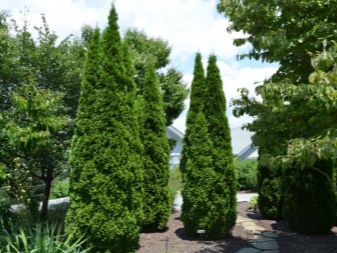
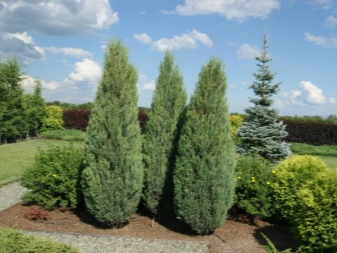
In the decorative design of the landscape, thujas are usually used no higher than 2-3 meters.
Taxonomic differences
Despite the fact that thuja and juniper are incredibly similar in appearance, they belong to different genera, however, they are located in the same cypress family. This means that both thuja and juniper are conifers. It is possible to note the characteristic differences between these plants and regarding their classification by varieties. So, today there are more than 60 varieties of juniper, while there are only 5 types of thuja.
This difference can be explained by the fact that some varieties of thuja were eventually marked by researchers as a full-fledged and independent genus of plants of the cypress family... A striking example of such plants is, for example, the oriental flatflower (considered a medicinal coniferous plant in oriental medicine).
Area
In addition to external and taxonomic differences, thuja and juniper also have differences regarding the distribution area. For example, if the juniper prefers to grow in the Northern Hemisphere with a climate range from the subarctic to the tropics, then thuja is more common in the temperate zone of the same Northern Hemisphere. As for the type of soil, both plants are unpretentious to it, but they need a moderate amount of moisture.
Application
The differences between these two plants consist not only in the listed characteristics, but also in the use of these crops by humans.
All parts of thuja are considered useful today and are used both in everyday life and in industry. One of the most useful elements of thuja is not its fruits (although they are also useful), namely needles, which have a huge amount of essential oils, resin and tannins. It is often grown for the sake of wood: it is a supplier of a huge amount of toxifylline and aromadendrin.
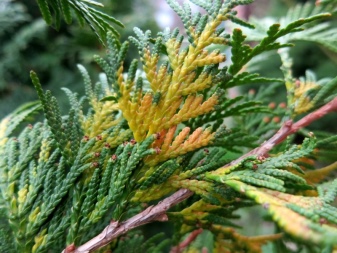
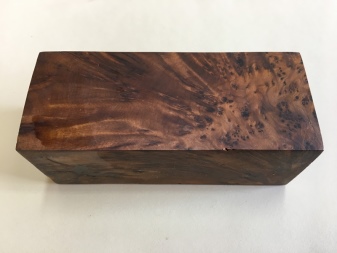
Today, thuja is actively used in alternative medicine, especially often the essential oil from thuja can be seen in the composition of homeopathic remedies. If we talk about Japan and China, there thuja is an indispensable element of medicine in the treatment of various diseases. On the territory of ancient Russia, healers preferred to use the tree - it was believed that it saved a person from diseases of the reproductive system, cystitis, rheumatism and enuresis.
Like thuja, juniper is actively used in modern medicine. On the basis of essential oil from juniper needles, many medicinal preparations are made.
Juniper is especially popular among folk healers and healers: here special infusions, decoctions, and even syrups are prepared from the fruits and needles of the plant.
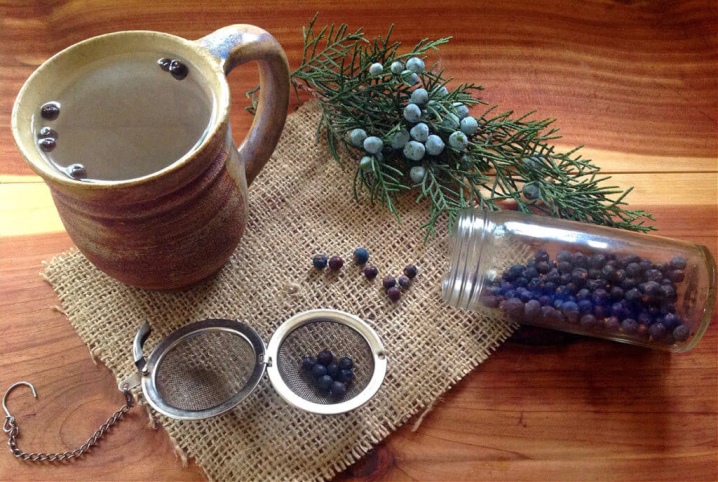
The difference between juniper and thuja is that it is actively used in cooking and food industry. Here it most often serves as a spice in the manufacture of alcoholic beverages.
Unlike thuja, in the composition of a juniper, the most valuable and useful element is not needles, but fruits. Ripe cones of healthy juniper contain up to 40% sugar, 10% resin and about 2% essential oil. Scientists have long found out that in terms of their richness in useful food acids (formic, acetic) and vitamin C, juniper fruits are much healthier and more valuable than most of the known berries.
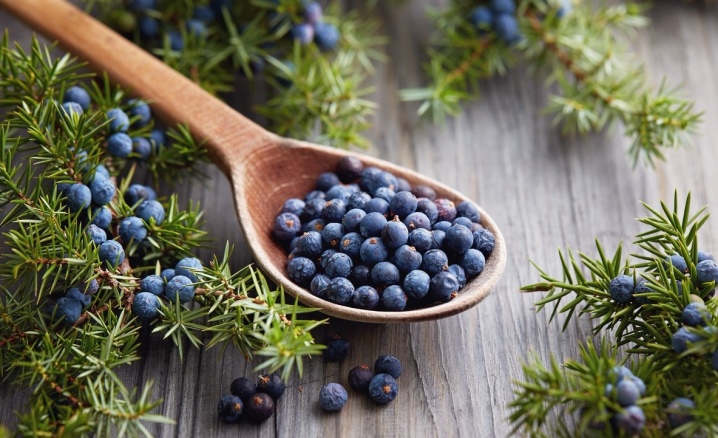
Types and varieties
In horticultural culture, only a few varieties of thuja are known today, based on which more than 90 separate varieties have been created. Each of these varieties was bred for a specific purpose. Some were bred exclusively for growing in cold regions, while others, due to their unique shape, look great in landscaping lawns and terraces.
Today, most of all varieties of thuja are subdivided into only three varieties: western, eastern and folded.
Western
This variety is represented by tall or dwarf plants, up to 20 meters in height.The main distribution area is North America. A feature of such a thuja is a characteristic cone-shaped top, which rounds out over time. The needles of this plant have a rich green color, they are elastic and flat, and are also lightened on the inside.
Among western thujas, the following varieties are most common:
- Danica - dwarf thuja of a round shape, which are characterized by bright green wavy needles;
- "Aureospicata" - it has a fast growth and a large crown diameter, up to 4.5 m;
- Golden - got this name due to the yellow tips of the branches;
- "Kuban emerald" - has a conical shape and rich green color.
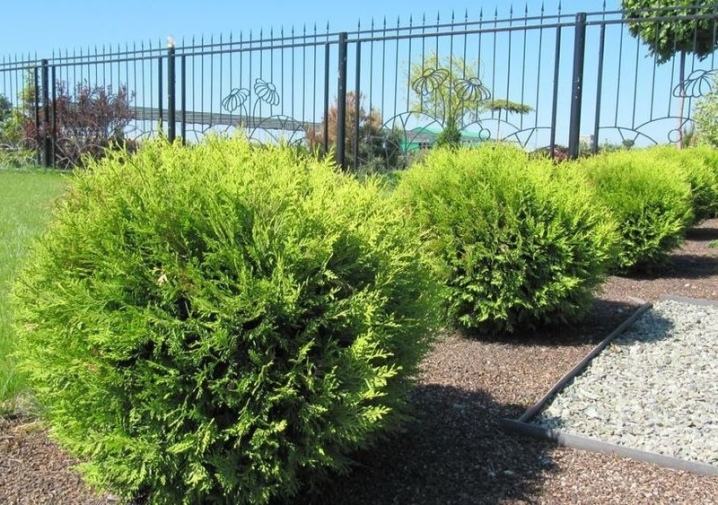
Eastern
Despite their name, these plants, from the point of view of botany, do not belong to thujas. Experienced gardeners prefer to call this coniferous culture an ornamental conifer. It is believed that this variety of thuja first appeared in Korea and China.
A distinctive feature is the bark of a rich brown or red color, as well as the fact that thujas of this type change color to red or golden in winter.
The most common varieties of the species include:
- "Aurea Nana" - differs in a small ovoid shape and slow growth;
- "Yustinka" - a popular plant in Poland, with good resistance to frost;
- "Morgan" - differs in slow growth and conical shape.

Folded
Unlike other types of thuja, it has a spreading structure of branches, it is very often found in the landscape design of cities. The most popular varieties in this case are "Vipkord" and "Zebrina".
Depending on the shape and size, thuja can also be divided into dwarf, spherical, pyramidal and columnar.
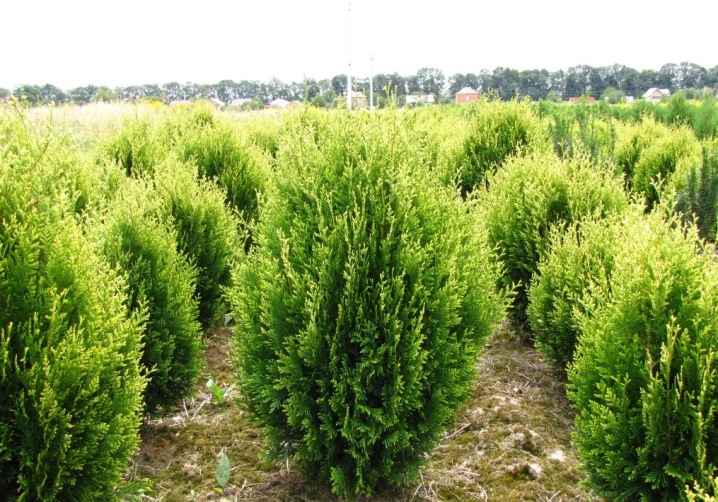
How to choose?
To choose the right plant, there are a number of important points to consider.
- Geography. Please note that thuja requires a moderate amount of heat and moisture, which is why it is recommended to plant them in areas with a temperate climate, and avoid planting in northern regions. On the territory of Russia, these plants show themselves best in the Leningrad region, where a large number of nurseries with thujas are located.
- Variety. Choose a thuja seedling based on its variety and your uses for the plant. For example, there are dwarf types of round thujas, which are most often used in landscaping landscaping. Some varieties of thuja have increased frost resistance, others have a stronger root system. Choose one based on the characteristics of your site and your needs.
- Drop off location. All varieties of thuja are more or less adapted for disembarkation in certain conditions. For example, erect thujas look great in the garden and as fences for paths on the street. High rectangular thuja often serve as a living fence for a summer residence, they are able to keep the site from prying eyes, as well as to qualitatively darken the required area. Dwarf round thuja are usually used in the design of garden paths, they also look great in flower beds along with other plants.
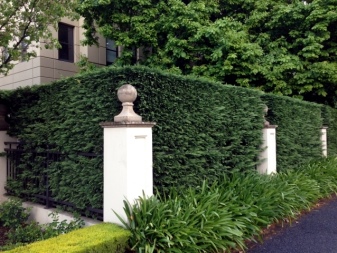
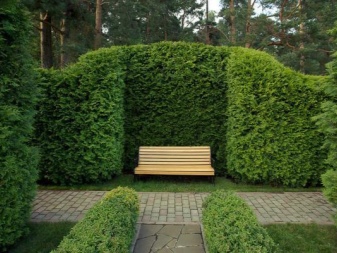
Now let's see how you should choose the seedling itself.
- The main condition is a lively and healthy appearance. The needles of the plant should be deep green or dark green in color, and also have a characteristic overflow. The needles should be elastic and resilient. If in front of you there is a plant with pale and weak needles, which crumble from the slightest touch, then the plant is either sick or has been without moisture for a long time.
- To keep the thuja fresh and healthy for a long time, sellers of garden plants try to sell the plants along with an earthen ball. You should not buy thuja seedlings in which the root system is completely bare.
- Examine the root system of the plant carefully, it should be intact and slightly damp. A healthy thuja root system has a pleasant white or slightly yellowish color. The roots of a healthy plant are resilient and release little moisture when scratched or squeezed.
- Specify the type of plant, ask the seller for data on frost resistance, splendor of the plant, as well as the expected color of the needles upon reaching the age of maturation.

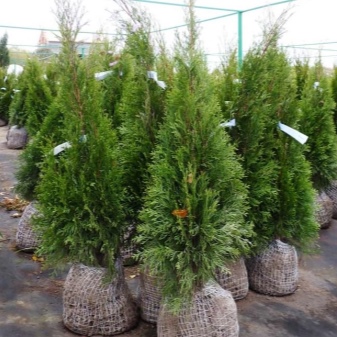
General landing rules
Before you start planting a plant, you should choose the most favorable site for it. Please note that thuja is very fond of light and sun, however, prefers to be under it only for a limited amount of time (for example, from morning to half of the day, or from 4 pm to sunset). Prolonged exposure to direct sunlight harms the thuja, they destroy the structure of the needles, which is why it loses its saturation, turns yellow and falls off. In addition to the influence of sunlight, do not expose the seedling to direct currents of cold wind. Even dense clothing made of pine needles cannot protect the plant from hypothermia.
Another important condition in choosing a place for planting thuja is correctly selected soil.
Almost all plants from the cypress family feel great in any type of soil, however, in order to maintain a pleasant and healthy look of the plant, it is advised to saturate the soil with nutrients at least once a year. The ideal soil option for thuja would be peat with elements of sod and sandstone.
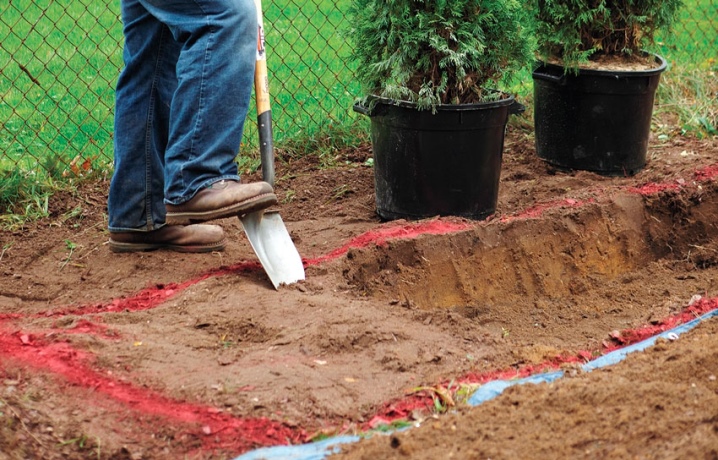
Planting can be carried out in any season except winter, but the first warm spring days are considered the ideal time. Some people prefer to plant thuja seedlings in early or late autumn. In this case, the plant may not have enough time to adapt to the external climate and deepen the root system.
The very process of planting a thuja can be presented in the form of the following brief instructions.
- Once you have chosen the place you need for planting, dig a hole 1x1 m and a depth of 80 cm.
- The bottom of the pit is slightly compacted and lined with drainage. Crushed stone or expanded clay can act as drainage. A drainage layer is necessary to drain excess moisture from under the roots of the plant.
- We spread the prepared soil or a mixture of different soils on the tamped soil. At this stage, it is worth adding ash and a minimum amount of fertilizers to the soil (specifically for conifers).
- Place the seedling in the hole and make sure the base of the roots is above ground level. In the future, the ground in the pit will settle, and the ground level will be leveled. In addition, such a slide does not allow moisture to accumulate near the base of the roots.
- When determining the distance for planting several thujas, pay attention to the type of plant. For example, for planting free-standing thujas, a distance of at least 2-3 meters between seedlings should be maintained, and to create a monolithic live and dense fence, plant thuja at a distance of 1 meter from each other.
- After planting the plant, do not forget to water it thoroughly (at least 1 bucket of water), loosen the ground near it, and also fence the seedling.
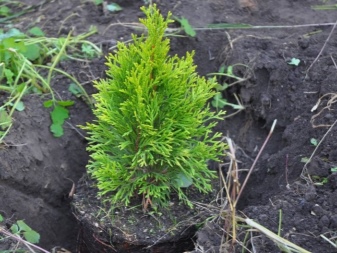
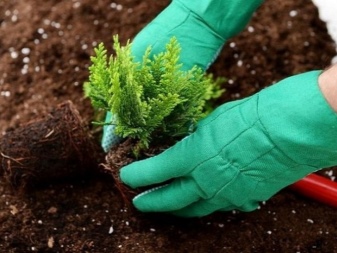
Care
Any plant needs care throughout the entire period of its growth on your site. The basis for caring for any garden plant is the following procedures: watering, fertilizing, pruning, transplanting and preparing for winter.
Watering
All plants from the cypress family simply adore a large amount of moisture: water makes the needles of the thuja more saturated, elastic and beautiful, promotes the development of the root system of the plant, which also leads to a rapid increase in the crown. After the procedure for planting a seedling, it should be watered daily for the first two weeks. For one seedling of a plant, you need to spend from 1 to 4 buckets of clean and cool water, the amount of water depends on the age and size of the plant. Do not forget to loosen the soil at the roots of the tree after watering so that the moisture is better absorbed. The loosening depth should be maintained up to 10 centimeters.
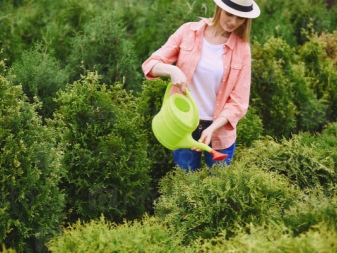

Many gardeners recommend the use of sprinklers for irrigation of thuja, which are able to maintain a stable flow of rainwater. Thus, moisture removes a layer of dust and dirt from the needles, making it more elastic and saturated.
Fertilizer
During periods of high humidity with sharp drops in temperatures and a lot of wind (spring or autumn), thuja need additional feeding with natural or mineral fertilizers. If you fed the plant at the time of planting (added fertilizers to the soil), then the next top dressing should be carried out no earlier than a year later. Thuja is a rare garden plant that is harmed by regular fertilization.
Pruning
Fortunately, almost all varieties of thuja respond remarkably to decorative pruning. The advantages of pruning a thuja will be indicated below.
- Thorough and correct pruning is believed to make the plant even more lush and bushy.
- Thinning the crown of the tree promotes ventilation inside the thuja and prevents branches from rotting and the formation of pest nests.
- Pruning allows you to give the plant the desired appearance, which is actively used in landscape design and the creation of plants with bizarre shapes.
- Prophylactic pruning removes any dry, dead, or painful twigs in the plant. This prevents the further development of diseases.
- In general, this procedure gives the plant a pleasant and well-groomed appearance.
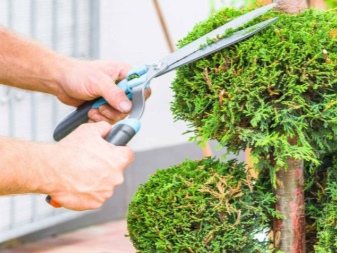
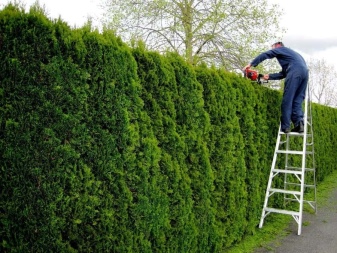
The pruning itself is advised to be carried out in the spring, before the bud opening period, however, some varieties of thuja need to be re-pruned in early October of the same year.
The very first pruning of a seedling should be carried out no earlier than the plant reaches two years of age. You should not completely remove the entire layer of needles from the plant, this will make the thuja defenseless against drafts, fog and cold. The pruning itself is carried out using special pruning shears or pruning shears.
Transfer
In the event that the place for the growth of thuja turned out to be unsuitable for some reason (lack of moisture, excessive amount of sun, drafts), a transplant procedure is allowed. Transplanting this plant cannot be called difficult, but there are also a number of its own rules.
- The first action is to preserve the natural earthen coma, in which the root system of the plant has already developed. To preserve this coma, it is advised, at a distance of at least half a meter from the base of the plant, to make as deep as possible undermines on 4 sides (this is also called piercing), so that a square is formed.
- After that, you should gently and slowly pry off the lump formed by an earthen lump, and pull it out of the ground by the base of the plant.
- Using a special box, car or wheelbarrow, move the thuja along with the earthen clod to a new planting site. Try not to fall apart and expose the roots of the plant during the transfer.
- The new pit should be equipped with the same method as the first - provide a drainage layer and add additional fertilizing. Again, make sure the base of the plant is slightly above ground level.
- After compacting the soil around the plant, be sure to water it thoroughly.
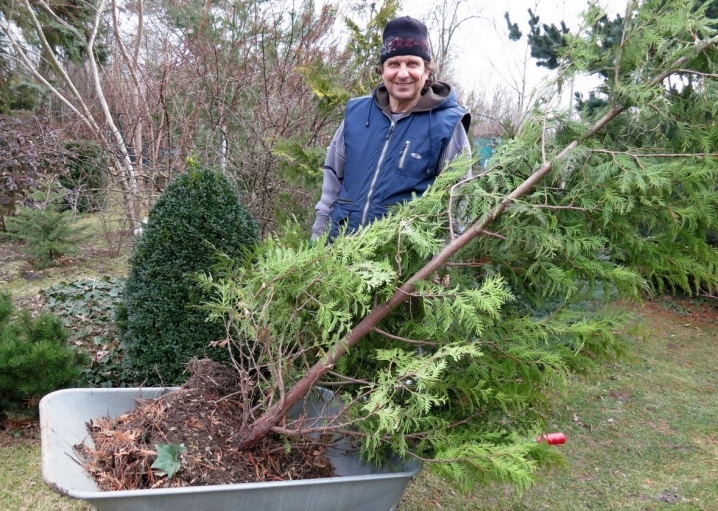
Some gardeners, when transplanting still young thujas, prefer to do the piercing a year before the transplant itself. This will cause the small roots of the plant to develop inside the earthy coma, close to the base. The transplant procedure in this case will not be as painful.
Preparing for winter
For regions with harsh, windy and cold winters (in Siberia or the Urals) and a large amount of snow, it is recommended to cover the thuja with a special material and tie it with twine to prevent injury to the branches by a large amount of snow. Be sure to provide the plant with a solid support that would keep the tree from falling, and save it from gusts of wind. The material will not only protect the plant from the cold, but also protect it from the harmful effects of winter sunlight.There are often cases when in early spring the bark of a thuja begins to crack.
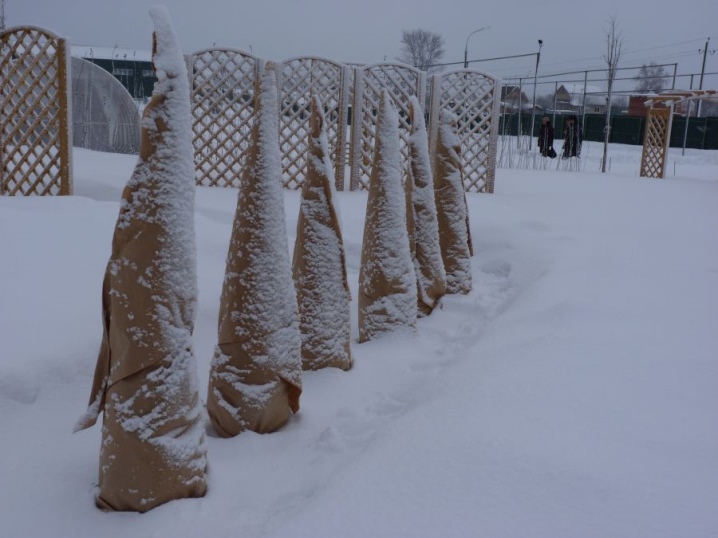
In this case, all cracks should be treated with garden varnish and pulled together with a cloth or twine.
Reproduction methods
Today, there are two ways to reproduce garden thuja: vegetative and seed. For each variety of thuja, one of the types is more preferable. For example, all varietal thuja or plants of the form type should be propagated in a vegetative way, only in this case there is a chance of preserving the maternal external qualities of the plant.
Seeds
The main disadvantage of reproduction through seeds is the duration of the process itself. Sometimes it can take up to 6 years, and in the best case it is 2 years. Moreover, this method does not allow preserving the maternal traits of the plant, and the seeds will need your constant care. This method is suitable for gardeners who prefer to grow a large number of thuja seedlings at once, which would be adapted to certain climatic conditions.
Another feature of thuja regarding seed cultivation - impossibility to predict neither the result of cultivation, nor the approximate time of emergence of the first shoots. In addition to the fact that the seeds can lie in the ground under ideal growing conditions for at least 2 years, they can also grow inconsistently. This does not allow us to accurately determine the number of successful seedlings in relation to seeds.
To obtain seeds, you should collect thuja cones in the year of fruiting. After that, place the fruits in a dry and warm place (in one layer) - within about two weeks, all the seeds should spill out of the plant by themselves.
Outwardly, they resemble oval pieces of thin red husk.
Planting seeds should be done in a small box with pre-moistened sand.
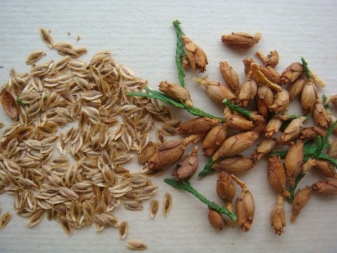
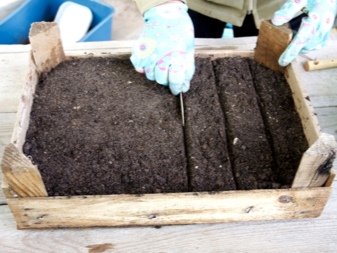
After that, cover the seeds with foil or sprinkle with sand and put them for about 2.5 months in a cool place with a temperature of 5-6 degrees (as a rule, a balcony or refrigerator is chosen). To avoid the accumulation of condensation under the film, the seeds should be ventilated at least once a week. This process is called stratification - it is the creation of artificial conditions with the influence of cold on the development of plants in the soil.
After the stratification procedure, you should transplant your seeds into separate boxes. A substrate of peat, sand and turf (in approximately equal proportions) should be used as a soil and a place for seed germination. The substrate must be diluted with a small amount of potassium permanganate in order to avoid the development of pests or infections in the soil.
Place the seed boxes in a well-ventilated area with an average temperature of 18-20 degrees. It is at this temperature that sprouts begin to emerge from the ground.
As soon as you notice the first shoots, immediately move the seed boxes to a cooler room with good lighting.
Remember to fertilize the soil with natural minerals regularly during emergence. The pick should be carried out no earlier than 2 years after the emergence of the seedling. It is best to carry it out in the spring, in the summer the boxes with seeds are taken out into the open air and placed in the shade, in the winter they are exhibited in a greenhouse or grown at home. In the third year after the seeds appear, place the thuja sprouts in larger containers. Only when the plant reaches a height of at least half a meter should it be planted in a permanent place.
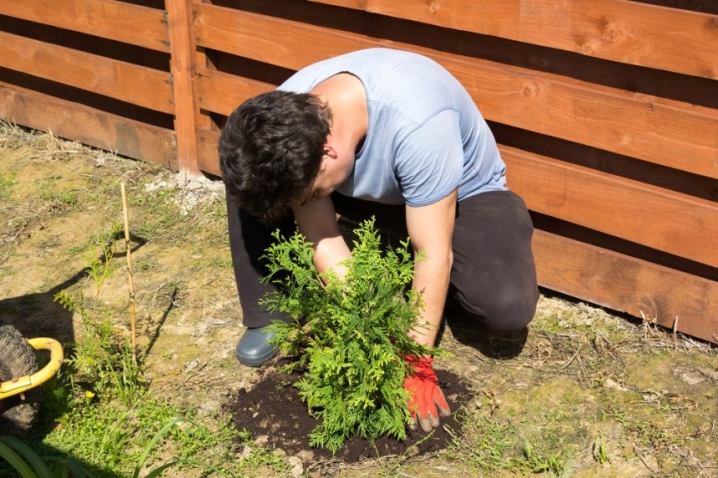
By cuttings
The peculiarity and advantage of this method is that it allows you to acquire new thuja seedlings in a short time and preserve all the maternal and varietal characteristics in them.
The process itself is usually carried out in mid-spring (April-early May). The material in this case is not seeds, but small and healthy branches of thuja not older than 3 years. If you have only adult thuja at your disposal, use semi-lignified twigs.Keep in mind that the cuttings should be broken off from the plant along with the heel (or the base of the attachment point of the branch to the trunk of the thuja).
Peel the lower part of the cuttings from the needles (in a ratio of 1: 3) and put it in a solution of a rooting stimulator for 24 hours. Then place the cutting in a greenhouse or box, covered with plastic, and deepen it by about 3 cm. The soil in this case should consist of peat, sand and sod soil, and the substrate should be pre-treated with a solution of potassium permanganate. To create ideal conditions for the germination of cuttings, humidity of less than 70% is required, as well as discreet but constant sunlight.
In order to achieve germination at home, it is recommended to cover the plants with glass jars and air them at least once every 2 days.
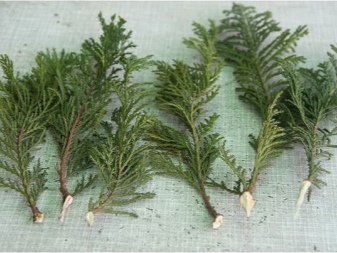
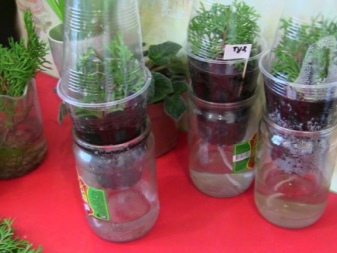
As soon as new shoots began to appear on the cuttings, this means that the roots of the plant have successfully taken root. In the same autumn, already matured cuttings should be planted in a permanent place. Unfortunately, care will also be required in winter - here special shelters or shelters are made for the cuttings, and the base at the roots is covered with mulch. Spruce or dry birch branches can be used as shelter.
Application in landscape design
As already mentioned, today thuja are an indispensable component in the design of any landscape design. Unlike other plants, all representatives of the cypress family are able to revive areas not only in summer, but also in winter.
Depending on the variety, thujas are capable of performing different roles in landscape design. For example, in an open area with a large number of small paths and flower beds, shrubs and dwarf thuja will look beautiful. To create a living fence and decorate a landscape terrace, tall varieties of tui are usually used. Among the most famous varieties in the design of the landscape interior, the following are usually used: "Brabant", "Smaragd", "Columna".
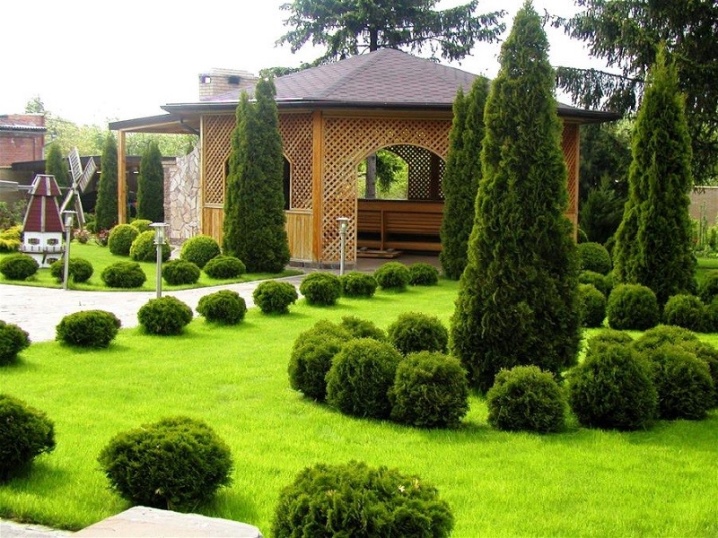
The uniqueness of thuja regarding landscape design is that with the help of haircuts and special forms, you can create real works of art from them, which are capable of making an evergreen paradise garden with bizarre figures from any mediocre plot.
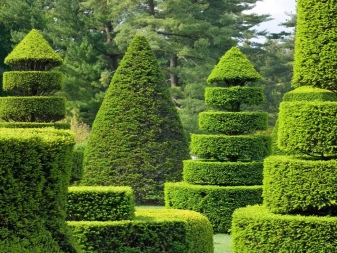
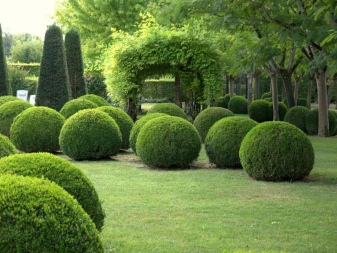
For more information on how to propagate and grow thuja, see the next video.



































































The comment was sent successfully.